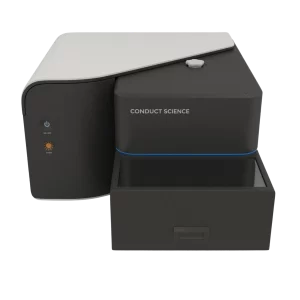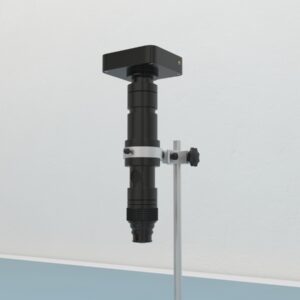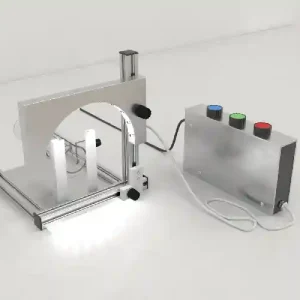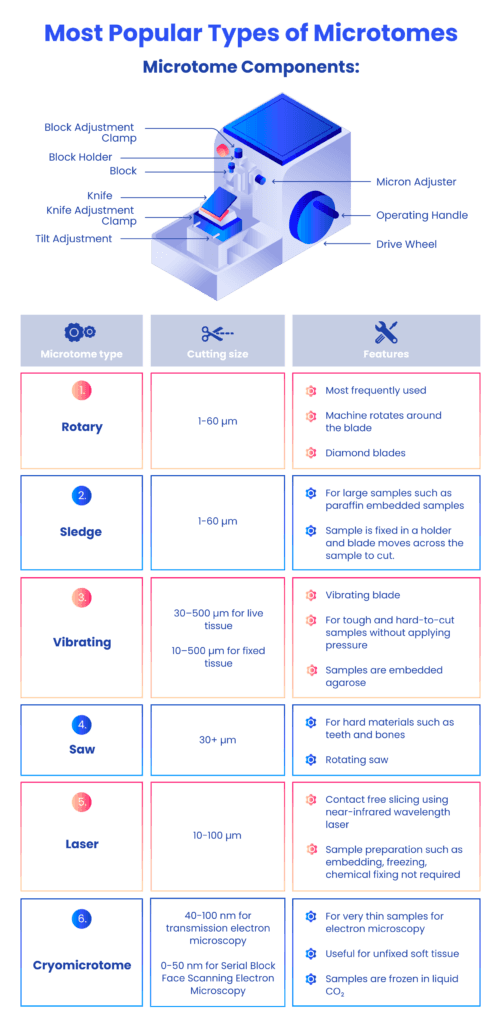$0.00
Conduct Science’s Automatic Rotary Microtome series, including the RF-RD-355AT (Standard Automatic) and RF–RD-355ATK (Precision Automatic) models, offers advanced solutions for automated tissue sectioning. These instruments combine the efficiency of motorized operation with high-level precision, crucial for modern histology and pathology laboratories.
The RF-RD-355AT provides reliable, consistent sectioning for routine tasks, ensuring reproducible, high-quality sections. Stepping up, the RF-RD-355ATK is engineered for even greater accuracy and handling of larger specimens, making it ideal for more demanding research and diagnostic applications. Both models feature intelligent control systems and enhanced safety measures, streamlining workflow while maintaining operator safety and sample integrity. They represent a significant upgrade for environments seeking to improve throughput and consistency in tissue preparationConductScience offers the Semi-Auto Microtome Solutions




Model | Standard Automated Microtome RF-RD-355AT | Precision Automated Microtome RF-RD-355ATK |
|---|---|---|
Section thickness setting range: | 0.5— 100um 0.5~2 µm increment 0.5 µm 2~10 µm increment 1 µm 10~20 µm increment 2 µm 20~50 µm increment 5 µm 50~100 µm increment 10 µm | 0.25—100μm 0.25—2.5μm increment 0.25μm 2.5—5μm increment 0.5μm 5.0—10μm increment 1μm 10—30μm increment 2μm 30—60μm increment 5μm 60—100μm increment 10μm |
Trimming thickness setting range: | 0—500 µm 1—10 µm increment 1µm 10—20 µm increment 2 µm 20—100 µm increment 10 µm 100—500 µm increment 100 µm | 1—600μm 1—10μm increment 1μm 10—20μm increment 2μm 20—50μm increment 5μm 50—150μm increment 10μm 150—600μm increment 50μm |
Specimen feed speed | 1250 µm/s (click), 2000µm/s (keep pressing). (forward and reverse with 3 speed is optional customization, 3 different speed is (500µm/s or 1000µm/s or 2000µm/s) | 1500μm/s ~ 3500μm/s |
Cutting speed | 0-300mm/s (0-400 or 500mm/s is optional customization) | 1500μm/s ~ 3500μm/s |
Precision and error: | ±5% | ±1% |
Specimen retraction setting range | 0-220 µm turn on or off is optional customization | 0—50μm ( 0 is off ) 5-10-15—50 (optional) |
Sample orientation | 8°along the X-Y-axis, rotate 360° | 8°along the X-Y-axis, rotate 360° |
Sample size | Standard Embedding box Maximum 50*45mm | 70×70mm (Larger capacity for bigger samples) (optional clamp) |
Horizontal specimen stroke | Standard 20mm,customization 28mm | Standard 20mm,customization 28mm |
Vertical specimen stroke | Standard 60mm,customization 70mm | Standard 60mm,customization 70mm |
Blade holder movement | Forward and backward:65mm Left and right:±20mm | Forward and backward:65mm Left and right:±20mm |
Section base angle range | 0-10° | 0-10° |
Blade height | 99mm | 99mm |
Working temperature/Humidity | Working temperature:18℃~25℃; /Humidity:≤80% | Working temperature:18℃~25℃; /Humidity:≤80% |
Working Atmospheric Pressure | 860hpa~1060hpa | 860hpa~1060hpa |
Product size | (L) 500mm* (W)320mm* (H)500mm | 580× 475× 340mm(W×D×H) |
Intelligent Control System: Utilizes an intelligent feeding system that enables quick switching between manual or automated smart sectioning modes, with adjustable automatic slicing speed.
Advanced Drive System & Multifunctionality: Features advanced drive systems offering multiple functions, including sectioning, trimming, fast forward, fast backward, quick mode conversion, and automatic specimen retraction.
Enhanced Safety Measures: Incorporates a safety and emergency braking system, security alarm system, driver overload protection, and an auto-sleep protection system for secure operation. The handwheel balance is precisely adjusted and can be locked at any position to ensure slicing safety.
Optimized Blade Management: The blade holder can be moved laterally to utilize the entire length of the blade across three different segments, avoiding direct contact. A red protection bar covers the blade’s full length, and a push bar facilitates easy blade changes.
User-Friendly Interface: Equipped with an OLED screen that displays section and trimming thickness, as well as the number of sections. It also includes a remote control panel for easy operation.
Versatile Specimen Handling: Offers precise orientation for the specimen clamp and allows for easy and fast switching between different specimen clamps, with options for both paraffin block and cassette clamps. It also includes a large-volume, easy-to-remove waste tray where disposable blades can be stored
Intelligent Control System: Features an intelligent feeding system that allows for quick and easy switching between manual and automated smart sectioning modes, with adjustable automatic slicing speed for optimal control.
Advanced Drive & Multi-functional Operation: Equipped with advanced drive systems, this microtome offers multiple functions including precise sectioning, trimming, fast forward, fast backward, quick mode conversion, and automatic retraction for streamlined workflow.
Superior Sectioning Precision: Utilizes an international advanced screw motion mechanism to ensure exceptional precision and stable sectioning performance, consistently delivering high-quality slices.
Enhanced Safety Features: Designed with user safety in mind, it includes emergency braking systems, security alarms, driver overload protection, an auto-sleep protection system, and a balanced hand-wheel that can be locked in any position.
Versatile Blade Management: The blade holder can be moved laterally to maximize blade utilization across three segments without direct contact, and includes a red protection bar and push bar for safe and easy blade changes.
User-Friendly Design & Waste Management: Features a pure-green digital display for essential parameters, offers easy switching between specimen clamps, and includes a large-volume, easily removable waste tray with top storage for disposable blades.

Manual rotary microtomes are essential tools in various scientific and medical fields, particularly in histology, pathology, and material science, where the preparation of thin, uniform tissue sections is critical for microscopic examination. Our manual microtomes offer reliable performance, ease of use, and robust construction, making them indispensable for both routine laboratory work and more specialized research applications. This series is designed to provide consistent, high-quality sections, enabling accurate diagnosis, detailed research, and effective material analysis.
The knife holder base holds the holder in place on the microtome stage. It can be moved to or away from the block, but it must remain fixed and secured during microtomy.
The knife holder comprises various parts, including the blade clamp, which holds the blade, the knife tilt, which adjusts the knife angle, and the faceplate, which directs the ribbons away from the blade and toward the operator.
The microtome body is a platform with rails that keeps the knife holder base in place.
The block holder or cassette clamp holds the paraffin block in place. The block usually slides up and down with each revolution while the blade remains stationary. The block holder may be equipped with knobs that enable the operator to move the block face in different directions to line the tissue with the blade.
The advancement handwheel rotates in one direction, moving the block closer to the knife at the preset microns.
The coarse handwheel moves the block closer or away from the knife.
Micron adjustment is used to adjust settings for slice thickness that vary from 1 to 60 microns.
The handwheel includes a safety lock that prevents the wheel from loosening and the block holder from falling towards the blade when inserting or removing a block.
The fundamental principle of all rotary microtomes, including our manual models, involves a precise mechanical action to achieve uniform tissue sections. A fixed tissue block, embedded in paraffin or resin, is mounted onto a specimen clamp. As the manual handwheel is rotated, a precisely engineered feeding mechanism advances the specimen block towards a stationary cutting blade. During each rotation, the specimen block moves past the blade, and a thin section of tissue is cleanly sliced off. The thickness of this section is determined by a highly accurate micrometer-based feed mechanism, which can be adjusted to increments as small as 1 micrometer. This continuous, controlled movement ensures that each section is of consistent thickness, critical for reproducible results in microscopy. Features like specimen retraction in models like the RD-315, RD-475, and RD-495 prevent the specimen from rubbing against the blade on the return stroke, extending blade life and improving section quality
The Rotary microtome is used to cut biological specimens according to the desired thickness ranging from 1 to 60 microns. It may be adapted to various types of tissue sectioning (hard, brittle, or fatty). However, it is not suitable for large tissue sectioning. Technological advancements in the rotary microtome have enhanced section quality, boosted production, and improved the technologist’s occupational safety.
The incidence of repetitive motion disorders, a frequent occupational health concern in the histology laboratory, may be reduced by eliminating the manual hand-wheel operation of the microtome. Disposable blades are used, eliminating the need for sharpening and increasing sample size accuracy. Additionally, knives can be used in place of blades; they are thick and large and produce fewer vibrations during microtomy. A high-resolution motor makes a stable and smooth automatic slicing system. Its heavier size makes it stable, and it is crucial to avoid undulations in the paraffin sections. A double locking system makes it secure and prevents injuries during block handling. An emergency button is used to stop the operation in danger. It is anti-static, non-waxing, and is very easy to clean. It has four different automatic slicing modes that cover a lot of sampling situations. Daily cleaning from paraffin residue maintains a microtome cutting ideally for many years.
The heavy size of the rotary microtome makes it less portable. The disposable blades are expensive and need to be handled with care to avoid accidents. Moreover, the knives get dull if they aren’t used on decalcified tissue that hasn’t been cleaned.
| Weight | 108 lbs |
|---|---|
| Dimensions | 69 × 59 × 50 cm |
| Model | Standard, Precision |
| Weight | 32KG |
| Voltage | AC220V/110V |
| Frequency | 50HZ/60Hz |
| Power | 100W |
| Fuse | F1A L 250V |
| Certification | CE; ISO; 13485 |
| Warranty | 2 years Lifetime technical support |
| Customization | Acceptance |
You must be logged in to post a review.
There are no questions yet. Be the first to ask a question about this product.
Monday – Friday
9 AM – 5 PM EST
DISCLAIMER: ConductScience and affiliate products are NOT designed for human consumption, testing, or clinical utilization. They are designed for pre-clinical utilization only. Customers purchasing apparatus for the purposes of scientific research or veterinary care affirm adherence to applicable regulatory bodies for the country in which their research or care is conducted.
Reviews
There are no reviews yet.